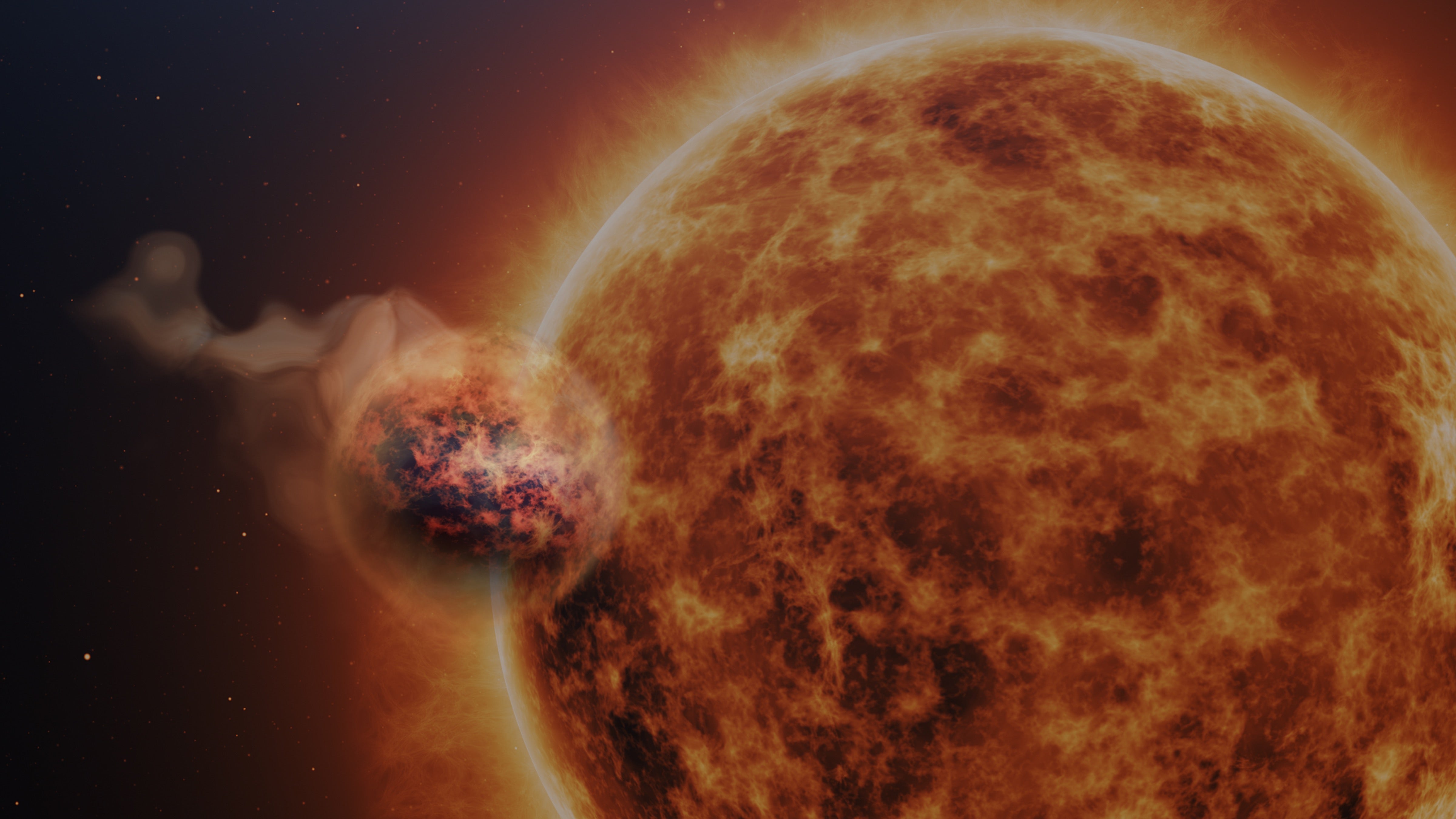
An artistic impression of WASP-107b and its parent star. Illustration: LUCA School of Arts, Belgium/ Klaas Verpoest (visuals), Johan Van Looveren (typography). Science: Achrène Dyrek (CEA and Université Paris Cité, France), Michiel Min (SRON, the Netherlands), Leen Decin (KU Leuven, Belgium) / European MIRI EXO GTO team / ESA / NASA
On WASP-107b, the word “sandstorm” should be taken literally.
The James Webb Space Telescope (JWST) recently looked at this strange, hot planet, located about 200 light-years away. JWST was specifically trying to peer into the atmosphere of the exoplanet to determine its chemistry.
And while Webb’s instruments found traces of water vapor and sulfur dioxide, they also detected clouds of silicon dioxide that behave similar to water clouds on Earth, meaning that on WASP-107b, it rains sand. (Sand is largely composed of silicon dioxide, very tiny particles of quartz.)
According to Leen Decin of the Institute of Astronomy at KU Leuven in Belgium, it’s “the first time that we have been able to identify the species that are forming clouds in an exoplanet atmosphere.” In other words, this is something like Webb’s first weather forecast.
Decin and her colleagues published the results of their research in Nature. The study is part of JWST’s broader examination of exoplanetary atmospheres. This study used the Low-Resolution Spectrometer aboard the Mid-Infrared Instrument (MIRI) to draw out the data.
WASP-107b is odd
WASP-107b is pretty unlike anything in our solar system. Superficially, it’s nearly the size of Jupiter, but under the hood, its mass is only about 30 times that of Earth, and it is classed as something of a super-Neptune. It orbits its star in just under six days, but this distance makes it considerably “colder,” at 700 Kelvins, than most exoplanets with sulfur dioxide have been. According to Decin, sulfur dioxide is typically detected in planetary atmospheres at 1,000 Kelvins or more. “So our models were not predicting any sulfur dioxide at all,” she says.
Some models have shown that exoplanets could contain silicates in their atmospheres. The sandstorming acts much like Earth’s water cycle, Decin says. “We have these little molecules. They condense deeper into the atmosphere, then they rise up. So you have this vertical transport and then they rain out again,” she says. “And so they come back again to places with higher temperatures and higher pressures.” And so it goes — brutal, molten rains of hot sand make up some of the weather on this unusual planet.
WASP-107b’s shape
What planetary scientists call WASP-107b’s “puffiness” can be attributed to the planet’s retention of a primordial envelope of hydrogen and helium, something that many planets of this mass may have shed. This is perplexing: WASP-107, the planet’s parent star, is older than the Sun, so such a primordial envelope should have been shed by now. The planet is shedding this envelope slowly, giving it a comet-like tail, but something else may have happened in its history.
Mercedes Lopez-Morales of the Center for Astrophysics, who was not involved in the study, says “one possible explanation is that the planets migrated in from further out in the system and only got to that location, close to the star, recently. That’s perhaps why even though its atmosphere is eroding — there are helium escape observations that prove it is — the planet has not lost all its gas yet.”
Lopez-Morales calls it an “exciting result,” with one of the big ways being the detection of silicon dioxide. It’s the second exoplanet to have silicon dioxide in its atmosphere after WASP-17b, which NASA and its JWST partners announced in October 2023. Lopez-Morales says that this demonstration of photochemistry is exciting, as it demonstrates that a process common on Earth happens on planets outside our solar system.
“But what is most exciting to me is that current photochemistry models do not predict SO2 to exist in a planet like WASP-107b,” Lopez-Morales says. “It seems like every time we look at a new exoplanet with JWST we discover something new.”
While WASP-107b seems unusual, Decin says it’s all part of building a complete picture of planet formation and the kinds of planets that exist in our galaxy and beyond.
“We would like to place WASP-107b into its family of super-Neptunes and other Neptune-like planets to really try to understand how can we get this kind of a planet there — how can we understand how planets form and evolve in general.”
JWST has plenty of other planetary observations on the horizon. Maybe it’ll turn out that WASP-107b isn’t so unusual after all.





